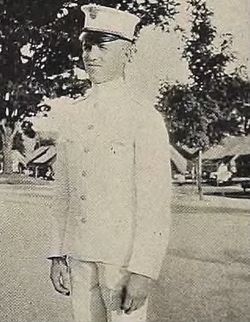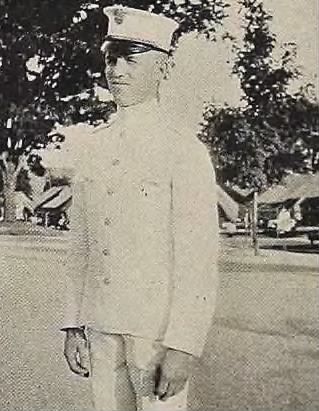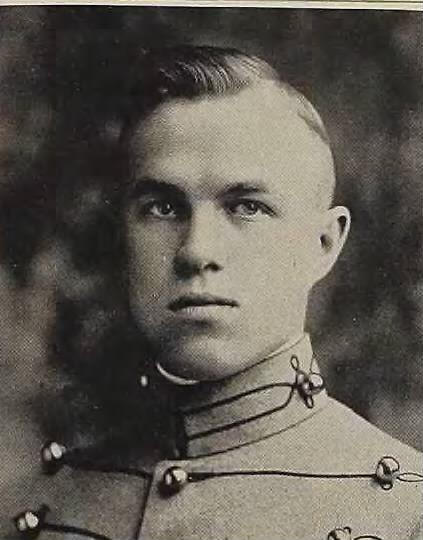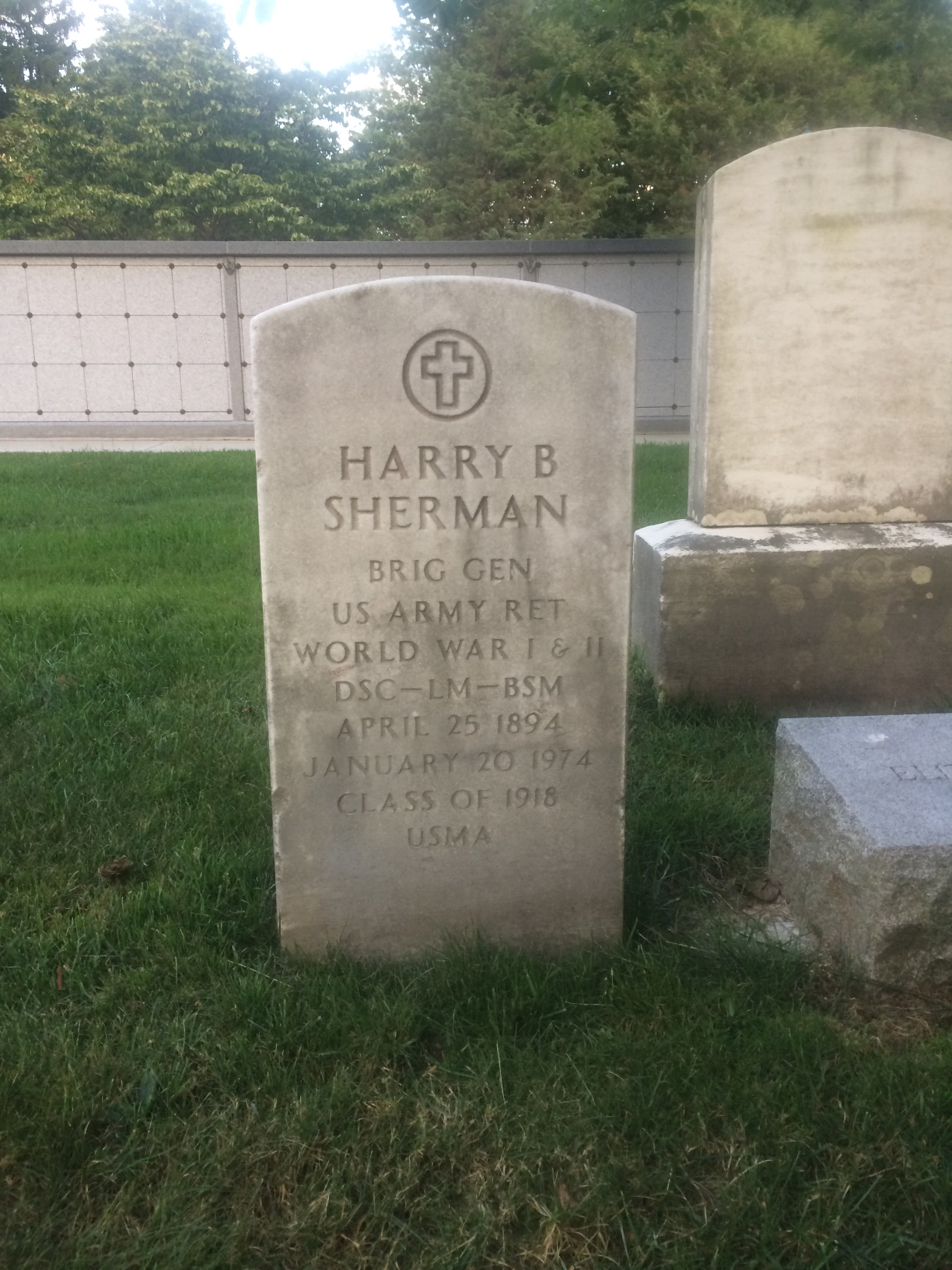He was the son of Daniel and Marilla Sherman. After graduating on June 12, 1918, he was commissioned a Second Lieutenant of Infantry. His first assignment was as a student officer at the School of Arms at Fort Sill, Oklahoma. In September 1918, he transferred to Camp Sheridan, Alabama, for duty with the 45th Infantry. From October 1918 to February 1919, he was aide to Brigadier General M.S. Jarvis at Camp McClellan in Alabama. He then rejoined the 45th Infantry at Camp Gordon, Georgia. In October 1919, he was assigned to the 50th Infantry at Camp Dix, New Jersey and went to Germany with that regiment. In April 1922, he returned to the United States. After assignments with the 5th Infantry at Fort Williams in Maine, and Camp Devens in Massachusetts, he was assigned as a student officer at The Tank School at Camp Meade, Maryland, in September 1923. After completing the course, he remained with the 1st Tank Group. Next, he went to The Infantry School at Fort Benning, Georgia and after graduation in May 1928, served with the Reserve Officers’ Training Corps at Fort Crook in Nebraska, and then as an instructor at the University of South Dakota until July 1932. After service with the 17th Infantry at Fort Leavenworth, Kansas, he was sent to Chilkoot Barracks, Alaska, for duty with the 7th Infantry. In September 1936, he returned to the 5th Infantry and accompanied them Panama in October 1939 for service at Camp Paraiso. He later commanded the Headquarters Company, Panama Mobile Force and the Panama Mobile Force Recruit Training Center until November 1941 when he returned to the United States. He then served with and later commanded the 15th Infantry. In February 1943, he assumed command of the 7th Infantry Regiment in French Morocco, North Africa. A year later he was named Assistant Commander of the 3rd Infantry Division. In November 1943, he went to Italy as the Assistant Commander of the 88th Infantry Division and in April 1944 became the Assistant Commander of the 34th Infantry Division. In December 1945, he returned to the United States as Assistant Commander of the 5th and later the 3rd Infantry Division. In February 1947, he assumed command of Camp Carson, Colorado. In August 1949, he was assigned to the Ryukyus Command, Okinawa as Deputy Chief of Military Government and later as Deputy Commander of the command. In April 1952, he returned to the United States and served as Commanding General at Fort McClellan, Alabama, until retirement in January 1953. He was promoted to First Lieutenant on October 11, 1919; to Captain on September 15, 1933; to Major on April 30, 1940; to Lieutenant Colonel on June 12, 1941; to Colonel on April 11, 1943 and to Brigadier General on June 2, 1944. He was made Brigadier General, permanent, on January 24, 1948. His awards included the Distinguished Service Cross for extraordinary heroism in action on September 24, 1943, the Legion of Merit for action in the Sicilian Offensive, 1943, the Bronze Star Medal, the Army Commendation Ribbon and the Italian Cross of Valor. Survivors included his wife, Eliza Crosby Sherman; two daughters including Eleanore Louise Sherman Sorensen of Burlingame, California; six grandchildren and four great-grandchildren.
Source: United States Military Academy Association of Graduates memorial.
He was the son of Daniel and Marilla Sherman. After graduating on June 12, 1918, he was commissioned a Second Lieutenant of Infantry. His first assignment was as a student officer at the School of Arms at Fort Sill, Oklahoma. In September 1918, he transferred to Camp Sheridan, Alabama, for duty with the 45th Infantry. From October 1918 to February 1919, he was aide to Brigadier General M.S. Jarvis at Camp McClellan in Alabama. He then rejoined the 45th Infantry at Camp Gordon, Georgia. In October 1919, he was assigned to the 50th Infantry at Camp Dix, New Jersey and went to Germany with that regiment. In April 1922, he returned to the United States. After assignments with the 5th Infantry at Fort Williams in Maine, and Camp Devens in Massachusetts, he was assigned as a student officer at The Tank School at Camp Meade, Maryland, in September 1923. After completing the course, he remained with the 1st Tank Group. Next, he went to The Infantry School at Fort Benning, Georgia and after graduation in May 1928, served with the Reserve Officers’ Training Corps at Fort Crook in Nebraska, and then as an instructor at the University of South Dakota until July 1932. After service with the 17th Infantry at Fort Leavenworth, Kansas, he was sent to Chilkoot Barracks, Alaska, for duty with the 7th Infantry. In September 1936, he returned to the 5th Infantry and accompanied them Panama in October 1939 for service at Camp Paraiso. He later commanded the Headquarters Company, Panama Mobile Force and the Panama Mobile Force Recruit Training Center until November 1941 when he returned to the United States. He then served with and later commanded the 15th Infantry. In February 1943, he assumed command of the 7th Infantry Regiment in French Morocco, North Africa. A year later he was named Assistant Commander of the 3rd Infantry Division. In November 1943, he went to Italy as the Assistant Commander of the 88th Infantry Division and in April 1944 became the Assistant Commander of the 34th Infantry Division. In December 1945, he returned to the United States as Assistant Commander of the 5th and later the 3rd Infantry Division. In February 1947, he assumed command of Camp Carson, Colorado. In August 1949, he was assigned to the Ryukyus Command, Okinawa as Deputy Chief of Military Government and later as Deputy Commander of the command. In April 1952, he returned to the United States and served as Commanding General at Fort McClellan, Alabama, until retirement in January 1953. He was promoted to First Lieutenant on October 11, 1919; to Captain on September 15, 1933; to Major on April 30, 1940; to Lieutenant Colonel on June 12, 1941; to Colonel on April 11, 1943 and to Brigadier General on June 2, 1944. He was made Brigadier General, permanent, on January 24, 1948. His awards included the Distinguished Service Cross for extraordinary heroism in action on September 24, 1943, the Legion of Merit for action in the Sicilian Offensive, 1943, the Bronze Star Medal, the Army Commendation Ribbon and the Italian Cross of Valor. Survivors included his wife, Eliza Crosby Sherman; two daughters including Eleanore Louise Sherman Sorensen of Burlingame, California; six grandchildren and four great-grandchildren.
Source: United States Military Academy Association of Graduates memorial.
Family Members
Sponsored by Ancestry
Advertisement
Advertisement







